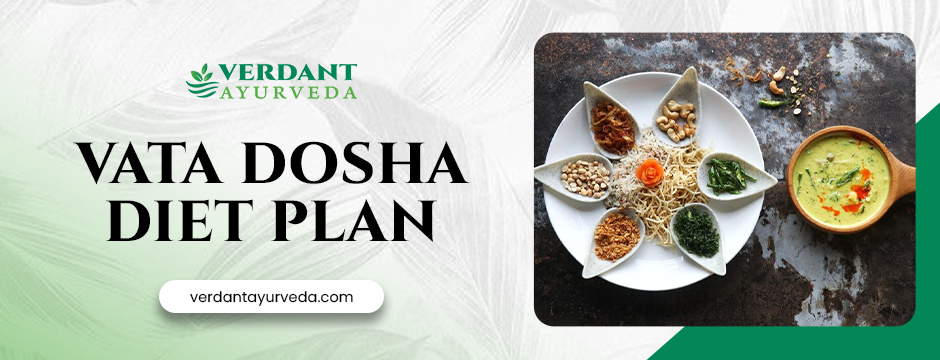
When the air gets dry and crisp during the fall and winter seasons, our bodies will automatically adjust to the seasonal change. During Ayurveda, this season is when Vata dosha is dominant. Vata is the movement energy, made up of air and space elements. Vata governs everything from circulation and breathing to thought and emotion.
But when Vata increases too much, especially during the colder season of the year, we will start to experience anxiety, scatteredness, dryness, or restlessness. So, we must have a warming, moistening, and calming Vata dosha diet plan this season to stay healthy and balanced.
So how do we adjust our eating habits to balance Vata during autumn and winter? Let’s find out.
Why You Should Have a Vata-Balancing Diet During Cold Months
The qualities of Vata—light, cold, and dry—are seen in the autumn and early winter weather. This can increase Vata in your system, whether you’re constitutionally Vata or not. You may notice changes like:
- Dry lips or skin
- Cold feet and hands
- Constipation or bloating
- Inability to sleep
- Racing mind
- Sudden loss of weight or poor appetite
By eating foods with opposite qualities—warm, oily, moist, heavy, and smooth—you can soothe the excess Vata.
Basic Guidelines to Vata-Balancing Foods
You don’t have to do much. Simply adopt a few simple concepts to bring your food in harmony with Vata-balancing requirements:
Eat cooked and warm food — Steer clear of raw salads or cold leftovers.
Include healthy fats — Add ghee, sesame oil, or olive oil liberally.
Stick to set eating times — Eat daily at the same hour.
Choose naturally sweet, salty, and sour foods — These are in balance with Vata.
Avoid dry, bitter, or pungent foods — These increase Vata’s dryness and volatility.
Use warm drinks as supplements — Herbal teas, warm water, or spiced milk are ideal.
Foods That Nourish Vata During Autumn and Winter
Let’s share what you should be adding to your vata dosha meal plan:
Grains
Softer, grounding grains are good for Vata. Try:
- Warm oatmeal
- Cooked rice (especially brown or basmati)
- Quinoa
- Wheat porridge
- Suji (semolina) meals
Steer clear of cold breakfast cereals, puffed rice, or dry granola bars.
Vegetables
Choose sweet, soft, and cooked vegetables. Steam, stew, or sauté them.
- Pumpkin
- Carrots
- Beets
- Sweet potatoes
- Bottle gourd (lauki)
- Spinach (well-cooked)
- Zucchini
Steer clear of raw salads, cauliflower, cabbage, and dry leafy greens.
Fruits
Choose sweet, juicy, and ripe fruits. Stew or cook them for extra warmth.
- Stewed pears or apples
- Bananas
- Mangoes
- Figs
- Grapes
- Dates and raisins (soaked)
Avoid sour or unripe fruits, and never eat straight from the fridge.
Dairy and Protein
Light, warm dairy and easy-to-digest proteins are best for Vata.
- Warm milk (with turmeric or nutmeg)
- Paneer (fresh Indian cheese)
- Ghee (clarified butter)
- Moong dal (yellow lentils)
- Almonds and walnuts (soaked)
- Tofu (in small amounts)
Skip yogurt at bedtime or straight from the refrigerator. It’s too sour and cold for Vata.
Oils and Fats
Good fats remove dryness from Vata and give energy.
- Sesame oil
- Ghee
- Olive oil
- Coconut oil (use minimally if it is too cooling)
Avoid processed or refined oils.
Spices and Herbs
Utilise warming spices in food and drinks.
- Ginger
- Cinnamon
- Cardamom
- Cumin
- Turmeric
- Clove
- Black pepper (in moderation)
Avoid overuse of chilli or harsh hot spices that can irritate digestion.
Beverages
Warming yourself from within.
- Herbal teas (ginger, tulsi, cinnamon)
- Warm lemon water
- Spiced milk with nutmeg
- Cumin-coriander-fennel tea
Avoid cold drinks, cold water, soda, and too much coffee.
Simple One-Day Vata Dosha Diet Plan
Here is an example of a nourishing and grounding Vata-friendly meal plan:
Morning
- Warm water with lemon or ginger
- Herbal tea
- Stewed apple with cinnamon and ghee
Breakfast
- Oatmeal with dates, almonds, and cardamom
- Warm almond milk or turmeric milk
Lunch
- Rice and moong dal khichdi
- Cooked carrot and pumpkin
- A spoon of ghee
- Warm cumin tea
Snack
- Soaked almonds or a banana
- Herbal tea
Dinner
- Soft roti or quinoa
- Spinach and sweet potato curry
- Turmeric paneer
- Warm spiced milk at night
Lifestyle Tips That Complement Your Diet
Food matters, but lifestyle also matters when balancing Vata.
- Get a regular routine. Vata adores predictability.
- Massage with oil. Daytime warm oil massage (abhyanga) with sesame oil calms Vata.
- Stay warm. Cover ears, feet, and neck in cold.
- Go slow. Don’t multitask, and allow time to rest.
- Sleep well. Sleep before 10 PM for good sleep.
What Not to Do in Autumn and Winter
Certain typical foods and habits can increase Vata. Be careful to avoid:
- Raw salads and dry snacks
- Chilled water or cold milkshakes
- Starving meals
- Hurrying meals
- Too much travel or computer use at night
- Noisy, chaotic environment
- Rather, choose quiet meals, mindful eating, and simple, warm food.
Final Thoughts
A Vata dosha diet plan doesn’t need to be complicated. Just bring in more warmth, moisture, and routine into your meals. Trust your body’s signals and take time to care for yourself as the seasons shift. Whether you’re new to Ayurveda or practising it for years, food can be your strongest medicine—especially in the Vata-dominant months of autumn and winter.
At Verdant Ayurveda, we help you regain balance in your life through personalised diet plans, Ayurvedic treatments, and comprehensive lifestyle changes. We’ll guide you along the road to balance and healing—one season at a time.
